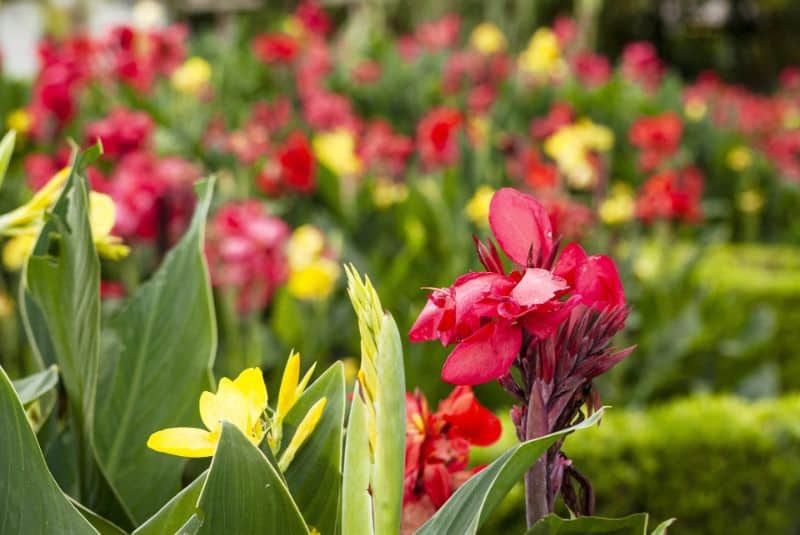If you are looking for a showy, tall flower to add to your garden, Canna lilies will be perfect for you! These flowers come in a variety of colors and can grow up to 8 feet tall. In this post, we will discuss how to grow and care for Canna lilies so that you can enjoy their beauty for years to come.
Best Canna Lily Varieties
| Image | Name | Rating | Shop |
|---|---|---|---|
 | Assorted Canna Lilies Red, Yellow, Pink, Orange | ||
 | Van Zyverden Giant Tall Mixed Cannas Bulbs | ||
 | Canna Lily Bulbs – The President Red Canna |
How to Grow and Care for Canna Lilies
Canna Lily Hardiness Zones
Canna lilies are perennial plants that grow in zones 7-10, USDA. They can be grown as annuals in cooler climates, and they can also be grown in pots so that they can be moved indoors during the winter.
How Much Sun Do Canna Lilies Need
Canna lilies need plenty of sun in order to thrive. They should be planted in an area that receives full sun for at least six hours each day. If you live in a climate with very hot summers, you may want to provide some afternoon shade for your canna lilies to protect them from the intense heat. During the fall and winter, canna lilies will go dormant and will not need as much sunlight. However, they will still benefit from being in a sunny spot during these months.
Canna Lily Soil Requirements
Canna lilies should be planted in rich, moist, well-draining soil. They prefer soils that are high in organic matter and you can amend sandy or marginal soil with compost or peat moss to achieve these conditions.
Canna Lily Soil pH
The optimal pH range for growing canna lilies is 6.0 to 6.5. For best results, test the soil’s pH level and adjust as necessary to keep it within that range. You can use a home soil testing kit or have your soil tested by a professional. If the pH level is too low or too high, you can add sulfur or lime to adjust the pH.
Canna Lily Plant Spacing
When choosing a final location for your canna lily plants, make sure to allow for 3 to 6 feet of space in between each one. This will ensure that each plant has enough room to grow and thrive. keep in mind that canna lilies can spread quite rapidly, so you may need to thin out your plants every few years to prevent them from taking over the garden.
Canna Lily Temperature Requirements
Canna lilies thrive in heat and prefer a temperature of around 90 degrees Fahrenheit. They can be grown as annuals in colder climates but will perform best if you provide them with a warm environment.
Canna Lily Fertilizer Requirements
Canna lilies are heavy feeders, so you’ll need to fertilize them monthly during the growing season. Look for a high phosphorus fertilizer with an NPK rating of 5-10-5. Apply the fertilizer according to package directions, taking care not to overdose the plants. Too much fertilizer can burn the roots and damage the plant.
Canna Lily Water Requirements
Canna lilies are tropical plants that require lots of water to thrive. You should water them once or twice a week, making sure to keep the soil moist but not soggy. Letting the soil dry out too much will stress the plant and could cause the leaves to turn yellow and drop off.
Canna Lily Humidity Requirements
Canna lilies are beautiful, tropical plants that absolutely love high humidity. They’ll thrive in any environment where they can get plenty of moisture, whether it’s from rain, misting, or even just the humid air itself. If you live in a particularly dry climate, you may need to give your cannas a little extra attention to make sure they stay hydrated. But as long as you keep an eye on them and make sure they’re getting enough water, they should do just fine.
Canna Lily Pests
The three most common pests that bother cannas are slugs, snails, and Japanese beetles. Slugs and snails eat old decaying foliage at the base of the plant, while Japanese beetles chew on new leaves and flowers.
Another less common pest that affects canna lilies is the canna leaf roller. This little bug wraps itself in a web around a lily leaf stopping it from unfurling. To get rid of canna leaf rollers, you can pick them off by hand or use an insecticidal spray.
Related Articles:
Canna Lily Diseases
If you’re growing cannas, it’s important to be aware of the various diseases that can affect them. These include rust fungus, canna mosaic virus, and aster yellows.
Rust fungus is one of the most common problems affecting cannas. This fungal disease creates orange-brown spots on the leaves, which eventually turn yellow and then brown.
Canna mosaic virus is another serious problem for these plants. This virus affects the leaves, causing them to develop mottled patterns of yellow and green.














